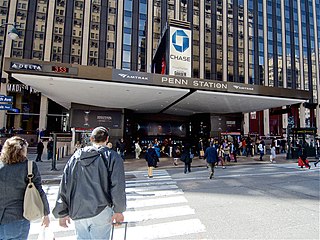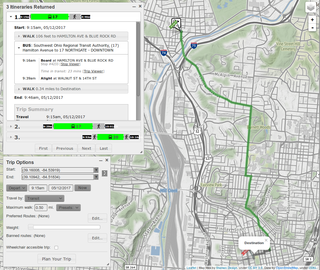There are a number of transport services around the Isle of Man, mostly consisting of paved roads, public transport, rail services, sea ports and an airport.

Berlin Tegel "Otto Lilienthal" Airport was the former primary international airport of Berlin, the federal capital of Germany. The airport was named after aviation pioneer Otto Lilienthal and was the fourth busiest airport in Germany, with over 24 million passengers in 2019. In 2016, Tegel handled over 60% of all airline passenger traffic in Berlin. The airport served as a base for Eurowings, Ryanair as well as easyJet. It featured flights to several European metropolitan and leisure destinations as well as some intercontinental routes. It was situated in Tegel, a section of the northern borough of Reinickendorf, eight kilometres northwest of the city centre of Berlin. Tegel Airport was notable for its hexagonal main terminal building around an open square, which made walking distances as short as 30 m (100 ft) from the aircraft to the terminal exit.

Airline timetables are printed pamphlets or folders that many airlines have traditionally used to inform passengers of several different things, such as schedules, fleet, security, in-flight entertainment, food menus, baggage weight restrictions, and contact information.

Boeing Field, officially King County International Airport, is a public airport owned and operated by King County, five miles south of downtown Seattle, Washington. The airport is sometimes referred to as KCIA, but it is not the airport identifier. The airport has scheduled passenger service operated by Kenmore Air, a commuter air carrier, and was being served by JSX with regional jet flights. It is also a hub for UPS Airlines. It is also used by other cargo airlines and general aviation aircraft. The airfield is named for founder of Boeing, William E. Boeing, and was constructed in 1928, serving as the city's primary airport until the opening of Seattle–Tacoma International Airport in 1944. The airport's property is mostly in Seattle just south of Georgetown, with its southern tip extending into Tukwila. The airport covers 634 acres (257 ha), averages more than 180,000 operations annually, and has approximately 380 based aircraft.

Erik Nielsen Whitehorse International Airport is an airport of entry located in Whitehorse, Yukon, Canada. It is part of the National Airports System, and is owned and operated by the Government of Yukon. The airport was renamed in honour of longtime Yukon Member of Parliament Erik Nielsen on December 15, 2008. The terminal handled 294,000 passengers in 2012, representing a 94% increase in passenger traffic since 2002. By 2017, this number had risen to 366,000. Air North is based in Whitehorse.

Lester B. Pearson International Airport, commonly known as Toronto Pearson International Airport, or simply Toronto Pearson or Pearson, is an international airport located in Mississauga, Ontario, Canada. It is the main airport serving Toronto, its metropolitan area, and the surrounding region known as the Golden Horseshoe. The airport is named in honour of Lester B. Pearson, who served as the 14th Prime minister of Canada and received the Nobel Peace Prize in 1957 for his humanitarian work in peacekeeping.

Juneau International Airport is a city-owned, public-use airport and seaplane base located seven nautical miles northwest of the central business district of Juneau, a city and borough in the U.S. state of Alaska that has no direct road access to the outside world. The airport serves as a regional hub for all air travel, from bush carriers to major U.S. air carriers such as Alaska Airlines.

In public transport, a request stop, flag stop, or whistle stop is a stop or station at which buses or trains, respectively, stop only on request; that is, only if there are passengers or freight to be picked up or dropped off. In this way, stops with low passenger counts can be incorporated into a route without introducing unnecessary delay. Vehicles may also save fuel by continuing through a station when there is no need to stop.

A schedule or a timetable, as a basic time-management tool, consists of a list of times at which possible tasks, events, or actions are intended to take place, or of a sequence of events in the chronological order in which such things are intended to take place. The process of creating a schedule — deciding how to order these tasks and how to commit resources between the variety of possible tasks — is called scheduling, and a person responsible for making a particular schedule may be called a scheduler. Making and following schedules is an ancient human activity.

A transport hub is a place where passengers and cargo are exchanged between vehicles and/or between transport modes. Public transport hubs include railway stations, rapid transit stations, bus stops, tram stops, airports and ferry slips. Freight hubs include classification yards, airports, seaports and truck terminals, or combinations of these. For private transport by car, the parking lot functions as a unimodal hub.

A public transport timetable is a document setting out information on public transport service times. Both public timetables to assist passengers with planning a trip and internal timetables to inform employees exist. Typically, the timetable will list the times when a service is scheduled to arrive at and depart from specified locations. It may show all movements at a particular location or all movements on a particular route or for a particular stop. Traditionally this information was provided in printed form, for example as a leaflet or poster. It is now also often available in a variety of electronic formats.
Cooma–Snowy Mountains Airport is an airport located in Coolringdon, 9 nautical miles southwest of Cooma, New South Wales, Australia. The airport serves the town of Cooma and the resorts of the Snowy Mountains and Australian Alps, experiencing increased traffic during the winter months.

Transport Aérien Transrégional was a French regional airline with its head office on the grounds of Tours Val de Loire Airport in Tours. It was formed in 1968 as Touraine Air Transport (TAT) by M. Marchais. Air France acquired a minority stake in the airline in 1989. Between 1993 and 1996 the company was gradually taken over by British Airways. It subsequently merged with Air Liberté.
In public transportation, schedule adherence or on-time performance refers to the level of success of the service remaining on the published schedule. On time performance, sometimes referred to as on time running, is normally expressed as a percentage, with a higher percentage meaning more vehicles are on time. The level of on time performance for many transport systems is a very important measure of the effectiveness of the system.

A journey planner, trip planner, or route planner is a specialized search engine used to find an optimal means of travelling between two or more given locations, sometimes using more than one transport mode. Searches may be optimized on different criteria, for example fastest, shortest, fewest changes, cheapest. They may be constrained, for example, to leave or arrive at a certain time, to avoid certain waypoints, etc. A single journey may use a sequence of several modes of transport, meaning the system may know about public transport services as well as transport networks for private transportation. Trip planning or journey planning is sometimes distinguished from route planning, which is typically thought of as using private modes of transportation such as cycling, driving, or walking, normally using a single mode at a time. Trip or journey planning, in contrast, would make use of at least one public transport mode which operates according to published schedules; given that public transport services only depart at specific times, an algorithm must therefore not only find a path to a destination, but seek to optimize it so as to minimize the waiting time incurred for each leg. In European Standards such as Transmodel, trip planning is used specifically to describe the planning of a route for a passenger, to avoid confusion with the completely separate process of planning the operational journeys to be made by public transport vehicles on which such trips are made.

Public transport bus services are generally based on regular operation of transit buses along a route calling at agreed bus stops according to a published public transport timetable. The state of Tamil Nadu in India operates the world's largest bus corporation called as TNSTC which is fully owned by Government of Tamil nadu, with a fleet of 20,258 buses and a daily ridership of 17 million.
A schedule is a time management tool consisting of a list of times at which events are to occur, or an order in which they are to occur.

A clock-face schedule, also cyclic schedule, is a timetable system under which public transport services run at consistent intervals, as opposed to a timetable that is purely driven by demand and has irregular headways. The name derives from the fact that departures take place at the same time or times during the day. For example, services with a half-hourly frequency might leave at 5:15, 5:45, 6:15, 6:45, 7:15, 7:45 etc.

Schedule padding—sometimes called simply padding, or recovery time—is some amount of 'additional' time added to part or all of a schedule, in excess of the expected duration, that allows it to be resilient to anticipated delays and increase the chance that the published schedule will be met. In some cases, excessive padding may be intentionally added to make it unlikely that the schedule won't be met, or to prefabricate an earlier-than-scheduled completion. Padding may have only a temporary positive impact, and many clients perceive this as a deceptive strategy.














